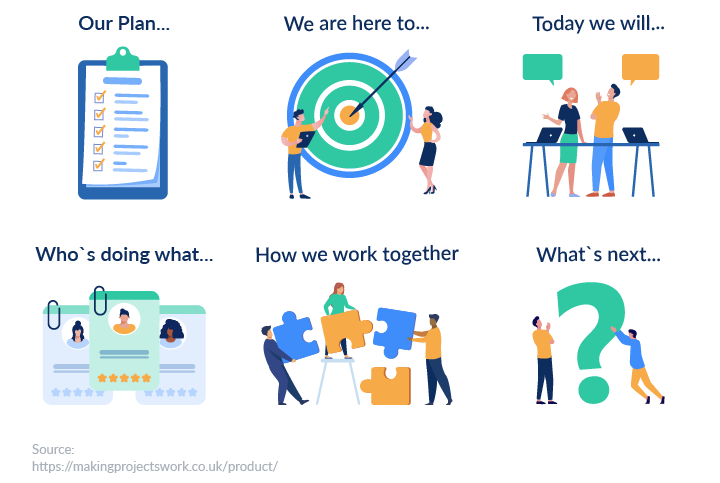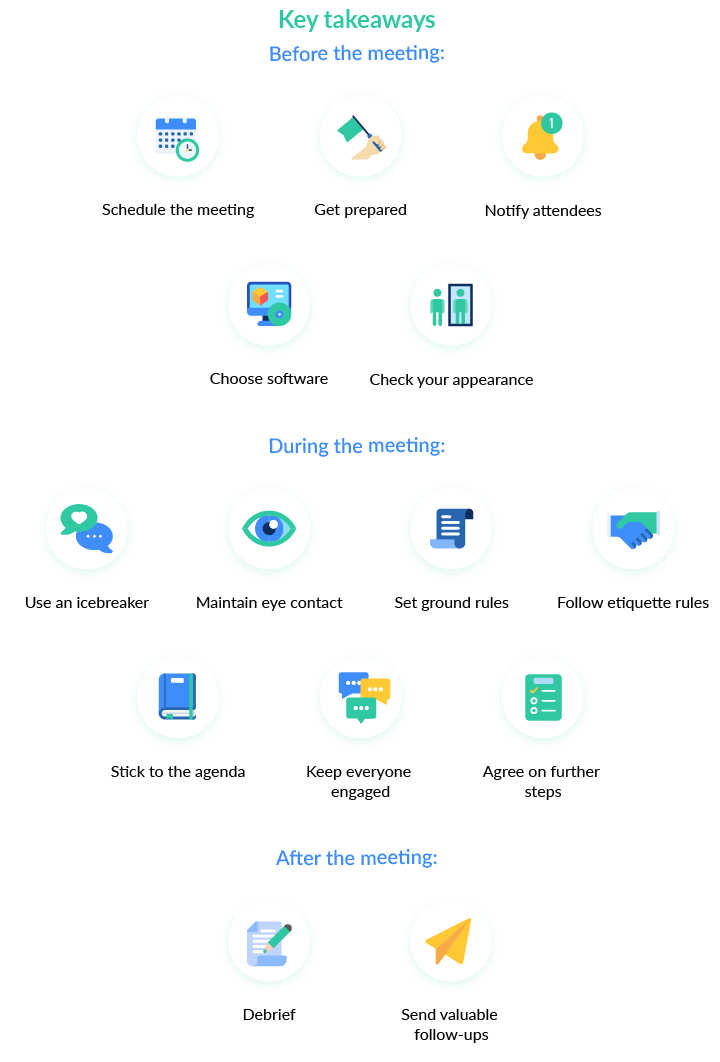You’ve just ended a virtual meeting, but the online conversation left you frustrated. It took longer than expected, you didn’t manage to cover all the agenda items, and some attendees couldn’t join. You have another meeting soon, and you don’t want it to be a waste of time like the previous one. We know how to help you. Read on!
Virtual meetings are becoming an integral part of today’s business workflow as companies worldwide embrace technology and shift to a remote work model because of the COVID-19 pandemic. Online meetings differ from face-to-face meetings, however, and seem to be more challenging to hold. By following our 14 tips for effective virtual meetings, you’ll be able to achieve your goals and make your meetings as productive as possible.
Before the meeting
Here are some steps you should take before the meeting.
#1. Schedule the meeting
Virtual meetings require careful planning, especially when they involve people from various locations. Take time to choose a date and time that’s convenient for every attendee. Take into account different time zones using The World Clock to prevent schedule conflicts. A shared calendar with each attendee’s available time slots can be an effective solution to schedule a meeting with minimum back-and-forth communication.
Pro tip: For more convenience, use scheduling software with an automated time zone converter.
#2. Get prepared

Preparation is crucial for effective meetings. Whether the meeting is face-to-face or virtual, you should have a clearly defined agenda, understand the purpose and the objective of your meeting, and set time limits for each agenda item. Knowing what you’re going to talk about with your colleagues or clients will allow you to be more productive and not get off the subject. You should understand why you’re gathering for a meeting and what your end goal is to achieve the desired outcome. Using a timed agenda ensures all items are covered and no time is wasted.
#3. Notify attendees
Sending an invite to all attendees will help inform everyone about the upcoming conversation and reduce the likelihood of people forgetting about it. Make sure you include the topic of discussion and a timed agenda in your invite so that each attendee can carefully prepare.
Sending notifications manually can be time-consuming, especially when there are multiple attendees. Consider using automated reminders to save time. Many video conferencing solutions feature automated appointment reminders so you don’t need to email or call attendees to remind them about upcoming meetings.
#4. Choose proper software and test it
Choosing the right video conferencing software is critical for effective virtual meetings. Select a tool based on your needs and requirements and keep in mind the following aspects while searching for the proper solution:
- Ease of use
- Audio/video quality
- Number of participants
- Recording functionality
- Screen sharing
- Chat functionality
- Mobile experience
Take time to review and test every platform before choosing the most appropriate. Make sure your selected platform runs smoothly to prevent technical problems during the meeting. Additionally, check whether it can work in low bandwidth conditions in case attendees suddenly have internet connection problems. Ensure all features you need are supported to achieve your meeting goals.
Pro tip: Opt for a software solution with a free trial to test it and check whether it meets all your needs.
Don’t forget to inform attendees about the software you’ve chosen so they can get acquainted with it, download and install it if necessary, and test it.
#5. Ensure you dress properly
The first thing people scan when they meet someone is their appearance. The way you look can affect the impression you make on your conversation partners. A survey by Qualified Communications recently published in the Harvard Business Review shows that most people care about a speaker’s background and appearance during a video call.
According to the survey, the safest choice is to opt for business casual and neutral colors unless you want to look innovative (then you may choose bright colors). Consider wearing formal attire to look more professional and be seen as an expert.

Before joining your virtual meeting, ensure you’re dressed appropriately. Place your webcam at eye level. This will create a good picture and reduce the strain on your neck as you won’t be looking at a low computer screen for a long time. Adjust your webcam to fully capture your face. Avoid sitting in front of windows to prevent your face from being darkened.
During the meeting
Let’s see what you should take into account during your virtual meeting.
#1. Start with an icebreaker
Virtual meetings may be more difficult to start than in-person meetings. An excellent idea is to use an icebreaker to create a friendly atmosphere. Ice breakers are especially helpful when you’re meeting your conversation partners for the first time. You may ask attendees to introduce themselves so they can get to know each other. If it’s a regular meeting, ask attendees some non-work-related questions like how they spent their weekend.
#2. Maintain eye contact
Eye contact is key to successful communication. As reported by researchers from Tampere University, Finland, eye contact is equally important during virtual meetings and face-to-face meetings; it impacts our nervous system in the same way whether we’re communicating in person or at a distance. When you maintain eye contact, listeners perceive you as confident, knowledgeable, respectful, and trustworthy. Besides, it helps you monitor people’s emotions and track whether they’re following your train of thought.
#3. Set ground rules
Setting ground rules is a helpful tip for effective virtual meetings as it allows you to guide all participants’ behavior. You may ask attendees to log in 10 minutes before the meeting to check their audio and video. A common rule is to ask people to mute their microphones until it’s their turn to speak. This helps cut down on background noise.
Pro tip: We recommend you choose software with a personal meeting room you can access before the meeting to prepare for the upcoming conversation.
If it’s your first time meeting, ask participants to log in with their full names so everyone can follow who says what. Another essential ground rule is to encourage attendees to put their cell phones on vibrate and put them away to stay focused and not miss important information. This is also a sign of respect for other meeting participants.
#4. Follow rules of etiquette
You should stick to some basic rules of etiquette to hold a smooth virtual meeting:
- Be punctual and come prepared.
- Introduce yourself and your colleagues at your first meeting.
- Speak clearly and leave short pauses to let everyone follow you, as there can be a two- or three-second sound delay.
- Maintain eye contact.
- Follow a proper dress code.
- Minimize body movements.
- Listen attentively while others are speaking and don’t interrupt them.
- Don’t do side tasks like texting or checking your email when in a meeting.
#5. Stick to the agenda and time limits
A clear, timed agenda helps keep everyone on track and helps you run an effective and productive virtual meeting. When each speaker adheres to the suggested agenda and time limits, you’re more likely to cover all significant items and reach your meeting goals. If issues arise requiring more time than allocated, it would be best to schedule another meeting to tackle them.
#6. Keep attendees engaged
A common problem of virtual meetings is that attendees may find it difficult to contribute and engage. As a meeting coordinator, your job is to provide enough opportunities for people to speak up. Get participants involved by asking questions that require them to contribute. For example, instead of saying “Now let’s discuss our plan. Who wants to speak first?” you might say “Now let’s discuss our plan. How about you go first and share your ideas, Ben?”
When all meeting attendees are involved, they’re less likely to get distracted. Consequently, you’re more likely to run an effective virtual meeting.
#7. Agree on further steps
Your meeting should result in a clearly defined action plan. Once you’ve discussed all agenda items, agree on further steps that should be taken to achieve the desired outcomes. Make sure you decide what your final objective is, what you need to do to reach it, and who is responsible for completing each task. Also, agree on deadlines for each deliverable to schedule the next meeting and monitor progress.

After the meeting
The meeting is over, but there are still some things you can do afterwards for a better post-meeting experience.
#1. Debrief
Debriefing is a useful post-meeting step. It’s used to discover what went wrong and what was done right as well as to improve the process and identify things that should be done differently at future meetings. Even when it seems that your meeting went without a hitch, there’s always room for improvement.
Debriefing can help you enhance the participant experience, receive valuable and constructive feedback, streamline the meeting process, and build team cohesion. You may do it through a casual conversation or by using feedback forms. Use whatever method you think will be the most transparent and effective.
#2. Send valuable follow-ups
This is probably the most important step to take right after your virtual meeting. Each attendee should walk out with a clear understanding of what to do next. To achieve your defined objectives, send valuable follow-ups to participants. These can be wrap-up notes on important issues, action items with people in charge and due dates, or a recording of your meeting if necessary.

Wrapping up
Effective virtual meetings require thorough preparation and a different approach compared to face-to-face conversations. Choosing a proper video conferencing tool is one of the crucial steps when preparing for an online meeting.
We’ve prepared an article on basic video conferencing software features and tips on choosing the best tool for your business. Read it to learn more.



